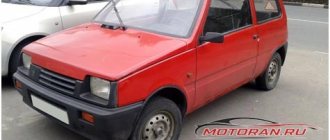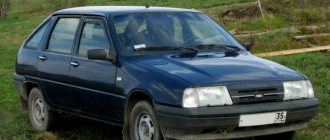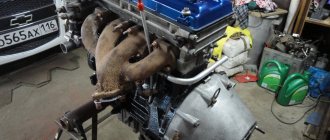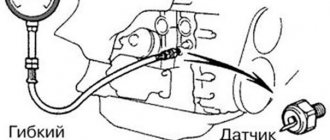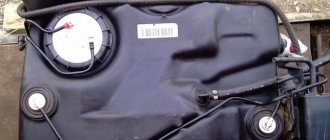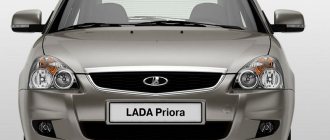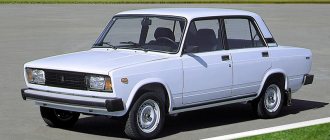The idea of creating a “people's car” has been in the air for a long time. Henry Ford took one of the first steps towards realizing his dream
.
With the introduction of his conveyor, the production of cars became much cheaper. In the thirties, the order to develop a “people's car” was received from the German government by the brilliant inventor Ferdinand Porsche
. In the Soviet Union, for decades, the main focus was on the development of public transport. As a result, Moscow and other cities received an excellent metro and a fairly developed bus, tram and trolleybus infrastructure. Until recently, cars remained the prerogative of a select few.
The situation began to change in the late eighties, when VAZ developed the Oka minicar model. At first, this car was in short supply. Only disabled people, Afghan veterans and a few other citizens who enjoyed government benefits could purchase it. Nowadays, the minicar has become an ordinary product available to anyone. Surprisingly, the design of the Oka still seems modern. At least in appearance, the car does not stand out much from its foreign counterparts. Moreover, we can say that the popular car is experiencing a rebirth today, receiving, in addition to the rather ascetic equipment, various additional equipment. For example, serious modification of the Oka was undertaken by one of the official dealers of the Serpukhov Automobile Plant, which sells the Prestige modification in Moscow.
Prehistory
In 1988, an especially small class car, the VAZ Oka, rolled off the AvtoVAZ assembly line. Subsequently, production was transferred to other factories, but the Serpukhov plant became the main one, with the corresponding model designation - SeAZ. But at the same time, the name of the model, “Oka,” remained unchanged.
The first model was the basic one and it had the Oka index 1111. Subsequently, several more models appeared that received improved technical characteristics and other indices. The most popular of them were models with indexes 1113 and 11116.
Production of this car stopped in 2008. Being practically the smallest domestically produced car, the VAZ 1111 had quite good technical characteristics for its class.
Vehicle identification
Like all cars, the Oka had identification numbers applied to the body and engine. The body number was additionally an identification designation of the car itself.
The identification number was applied to the car body in three places, which eliminated the possibility of counterfeiting. The first number was applied to a special plate attached to the front of the body, in the engine compartment. This plate also carried information in the form of a code about the manufacturer; the model index and model year of manufacture were applied to it.
The identification number was additionally applied to the body under the air intake grille located near the windshield.
The third number was applied inside the cabin, on the cross member of the trunk floor.
The engine had an identification number in only one place - on the front cylinder block, next to the second cylinder.
Related link:
Generator OKA
Dimensions
All versions of the car had a monocoque three-door body, and the car was designed for 4 passengers. Despite the fact that three different models were produced, their overall dimensions were identical. The length of the car was only 3200 mm, with a width of 1420 mm, and almost the same height - 1400 mm. At the same time, the wheelbase of the Oka was 2180 mm. The ground clearance for all models was 150 mm. But they differed in curb weight: 1111 had a weight of 640 kg, 1113 had 645 kg, and 11116 had 665 kg. The use of engines with different design features had an effect.
Reviews
I read reviews on the Internet about OKA cars of various modifications. Let me tell you in a nutshell. Many people do not like this car because of its appearance, but many are pleased that it is a simple, easy to repair, two-cylinder internal combustion engine with two valves. Another disadvantage is that it is lightweight, and when driving along the highway behind an oncoming truck or van, the Oka is practically blown away by the wind. In addition, one of the disadvantages is that the distance between the wheels is less than that of standard cars, so in winter it does not get into ruts and throws them out. Some call it the "crazy stool."
As for me, you can take it if you do not travel long distances, for example, a postman delivers a newspaper. Fuel consumption is low.
Engines and transmissions
The Oka engine had different characteristics, depending on the model. Oka 1111 and 1113 were equipped with two-cylinder power units with synchronous piston stroke and a balancing mechanism. The power system is carburetor, cooling is liquid, and the ignition system is electronic non-contact, using a Hall sensor.
For Oka 1111, the technical characteristics of the engine were reduced to a total volume of combustion chambers of 0.649 liters and a power of 29.3 hp. In fact, it was half of the 1.3-liter engine of the VAZ-2108 model.
The SeAZ-1113 had a larger volume - 0.75 liters, and the power was also higher - 33.0 hp.
SeAZ 11116 had slightly different technical characteristics. This model, which appeared later than all others, was equipped with a Chinese power plant with 3 cylinders. The working volume of this unit was already 1.0 liter, and the power it produced was 53 hp.
Article on the topic - Design of the OKI (SeAZ) engine
All cars were front-wheel drive. On versions 1111 and 1113, a 4-speed gearbox was used, equipped with synchronizers for each gear.
The maximum speed of Oka 1111 was 115 km/h, and 1113 – 130 km/h.
The Chinese engine version 11116 was already paired with a 5-speed gearbox. This made it possible to accelerate the car to 150 km/h.
Related link:
Clutch OKA
Technical characteristics of SeAZ OKA 11113
Main settings | |
| Equipment name | Basic 11113 |
| Release period | 1996 — 2006 |
| type of drive | Front |
| Body type | Hatchback |
| Transmission type | Manual transmission 4 |
| Engine capacity, cc | 749 |
| Body brand | 1111 |
| Acceleration time to 100 km/h, seconds | 24 |
| Maximum speed, km/h | 135 |
| Ground clearance (ride height), mm | 150 |
| Number of doors | 3 |
| Steering wheel position | left |
Dimensions | |
| Body dimensions | |
| Body dimensions (L x W x H), mm | 3200 x 1420 x 1400 |
| Interior dimensions | |
| Number of places | 4 |
| Number of seat rows | 2 |
Characteristics of the car chassis | |
| Wheelbase, mm | 2180 |
| Minimum turning radius, m | 4.6 |
| Front track width, mm | 1210 |
| Rear track width, mm | 1200 |
Weight and permissible loads | |
| Weight, kg | 645 |
| Permissible total weight, kg | 985 |
Volumes | |
| Fuel tank volume, l | 30 |
| Trunk volume, l | 210 (630) |
Engine, gearbox and steering | |
| ICE | |
| Engine make | VAZ-11113 |
| Maximum power, hp (kW) at rpm | 33 (24) / 5600 |
| Maximum torque, N*m (kg*m) at rpm. | 50 (5) / 3200 |
| engine's type | In-line, 2-cylinder |
| Add. engine information | Carburetor, overhead valve timing system with overhead camshaft |
| Type of fuel | Gasoline AI-92 |
| Cylinder diameter, mm | 82 |
| Piston stroke length, mm | 71 |
| Turbine | — |
| Number of valves per cylinder | 2 |
| Specific power, kg/hp | 19.55 |
Fuel consumption | |
| Fuel consumption in the city, l/100 km | 7.4 |
| Fuel consumption outside the city, l/100 km | 5 |
| Fuel consumption in mixed mode, l/100 km | 6,8 |
Steering | |
| Steering type | Rack and pinion |
Suspension / Chassis | |
| Suspension | |
| Front stabilizer | |
| Front suspension | Independent, MacPherson-type shock-absorbing strut |
| Rear suspension | Semi-independent, torsion beam |
Discs | |
| Disk size | 3.0J×12 |
Tires | |
| Tire size | 135/80 R12 Reviews of tires 135/80 R12 Buy tires 135/80 R12 |
Brakes | |
| Front brakes | Disk |
| Rear brakes | Drums |
Internal equipment | |
| Add. interior equipment | |
| Cooled glove box | — |
Active and passive safety systems | |
| Electronic safety and traffic control systems | |
| Anti-lock braking system (ABS) | — |
Driver kit | |
| Full size spare wheel | |
Do you remember question #20 of ticket #34: How to do CPR?
Suspension, steering, braking system
The front of the car was equipped with a MacPherson-type suspension, with telescopic shock absorbers, wishbones and a transverse stabilizer bar. At the rear, a suspension was used, consisting of shock absorbers, coil springs, trailing arms and a transverse beam.
Steering "Oka" ...
injury-proof, made of the “rack and pinion” type. The transmission of force from it to the wheels was carried out by two steering rods.
The front wheels were equipped with disc brakes...
the caliper was movable. The gaps between the caliper and the pads were adjusted automatically.
The rear wheels had drum mechanisms; the gap between the shoes and the drum was adjusted automatically. The drive of the service brakes was hydraulic, while the parking brake had a cable drive.
Article on the topic - OKA suspension: diagnostics and malfunctions
On-board electrical network…
the car was single-wire, the negative pole was the body itself. The nominal voltage in the network was 12 V. The voltage in the network was maintained by two sources - the battery and the generator.
In general, the Oka car was very interesting, but the unprofitability of production and lack of competitiveness with foreign cars of this class led to the curtailment of its production.
VAZ-1111 "Oka"
Despite the incredibly compact appearance, there is more space in the interior of the VAZ-1111 Oka than it seems. Even tall people can easily fit in the front seats; the rear seats are more problematic. The instrument panel is simplified as much as possible, the instrument cluster is used from the VAZ-2101, but over the years of its production the instrument panel has changed several times. There is a lot of metal in the cabin that is not covered with decorative overlays, and there is no glove box. In general, everything is more than simple.
The suspension design is traditional for front-wheel drive VAZ cars, the front suspension is of the MacPherson type with a stabilizer bar, and the rear suspension uses a transverse flexible beam.
The braking system, like most cars of those times, is hydraulic with disc brakes in the front and drum brakes in the rear. The wheels are small - 12 inches, and later examples had 13-inch wheels.
Initially, the car was planned to be equipped with a new three-cylinder engine, but by that time the country did not have its own development of small engines for cars of this class. It was decided to install a reduced-size serial VAZ engine. For these purposes, they took an engine from a 1.3-liter VAZ-2108 car, and, relatively speaking, cut off half of it, resulting in a new, modified two-cylinder engine with a volume of 649 cm3 and a power of 29.7 hp. which was installed on the VAZ-1111 Oka car.
The VAZ-1111, in addition to half of the G8 engine, also had a cooling system completely similar to the VAZ-2108 with a thermostat blocking the movement of coolant through the main radiator until it reaches operating temperature. The coolant pump was also inherited from the G8, which confidently copes with its task even in hot weather. In the cold season, there was a problem with the engine underheating due to strong heat extraction from the heater.
In the mid-90s, the car received a new two-cylinder engine, which was the “half” of the VAZ-21083 engine. The engine capacity was 749 cm3, and the power reached 33 horsepower.
In 2006, SeAZ launched production of the SeAZ-11116 modification, which was equipped with an imported 3-cylinder Chinese-made injection engine with a volume of 993 cm3 and a power of 53 horsepower. For the first time, a 5-speed manual transmission was used for this modification; previously only a 4-speed gearbox was installed.
